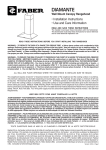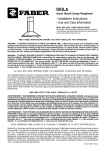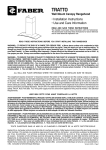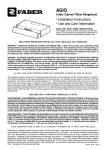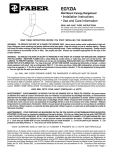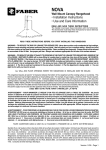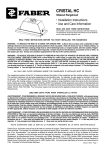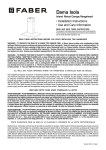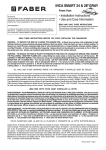Download Faber Matrix User's Manual
Transcript
MATRIX Wall Mount Luxury Rangehood • Installation Instructions • Use and Care Information READ AND SAVE THESE INSTRUCTIONS The Installer must leave these instructions with the homeowner. The homeowner must keep these instructions for future reference and for local electrical inspectors' use. READ THESE INSTRUCTIONS BEFORE YOU START INSTALLING THIS RANGEHOOD WARNING: - TO REDUCE THE RISK OF A RANGE TOP GREASE FIRE: a) Never leave surface units unattended at high settings. Boilovers cause smoking and greasy spillovers that may ignite. Heat oils slowly on low or medium setting. b) Always turn hood ON when cooking at high heat or when flambeing food (i.e. Crepes Suzette, Cherries Jubilee, Peppercorn Beef Flambé). c) Clean ventilating fans frequently. Grease should not be allowed to accumulate on fan or filter. d) Use proper pan size. Always use cookware appropriate for the size of the surface element. WARNING: - TO REDUCE THE RISK OF INJURY TO PERSONS IN THE EVENT OF A RANGE TOP GREASE FIRE, OBSERVE THE FOLLOWING: SMOTHER FLAMES with a close-fitting lid, cookie sheet, or metal tray, then turn off the burner. BE CAREFUL TO PREVENT BURNS. If the flames do not go out immediately EVACUATE AND CALL THE FIRE DEPARTMENT. NEVER PICK UP A FLAMING PAN - You may be burned. DO NOT USE WATER, including wet dishcloths or towels - a violent steam explosion will result. Use an extinguisher ONLY if: 1. You know you have a Class ABC extinguisher, and you already know how to operate it. 2. The fire is small and contained in the area where it started. 3. The fire department is being called. 4. You can fight the fire with your back to an exit. ALL WALL AND FLOOR OPENINGS WHERE THE RANGEHOOD IS INSTALLED MUST BE SEALED. This rangehood requires at least 15" of clearance between the bottom of the rangehood and the cooking surface or countertop. This hood has been approved by UL at this distance from the cooktop. The maximum depth of overhead cabinets is 13". Overhead cabinets on both sides of this unit must be a minimum of 18" above the cooking surface or countertop. Consult the cooktop or range installation instructions given by the manufacturer before making any cutouts. MOBILE HOME INSTALLATION The installation of this rangehood must conform to the Manufactured Home Construction and Safety Standards, Title 24 CFR, Part 3280 (formerly Federal Standard for Mobile Home Construction and Safety, Title 24, HUD, Part 280). Four wire power supply must be used and the appliance wiring must be revised. See Electrical Requirements. LISEZ BIEN CETTE FICHE AVANT D'INSTALLER LA HOTTE AVERTISSEMENT - POUR MINIMISER LE RISQUE DʼUN FEU DE GRAISSE SUR LA TABLE DE CUISSON : a) Ne jamais laisser un élément de la table de cuisson fonctionner sans surveillance à la puissance de chauffage maximale; un renversement/ débordement de matière graisseuse pourrait provoquer une inflammation et le génération de fumée. Utiliser toujours une puissance de chauffage moyenne ou basse pour le chauffage dʼhuile. b) Veiller à toujours faire fonctionner le ventilateur de la hotte lors dʼune cuisson avec une puissance de chauffage élevée ou lors de la cuisson dʼun mets à flamber (i.e. Crepes Suzette, Cherries Jubilee, Peppercorn Beef Flambé). c) Nettoyer fréquemment les ventilateurs dʼextraction. Veiller à ne pas laisser de la graisse sʼaccumuler sur les surfaces du ventilateur ou des filtres. d) Utiliser toujours un ustensile de taille appropriée. Utiliser toujours un ustensile de taille adapté à la taille de lʼélément chauffant. AVERTISSEMENT: - POUR PRÉVENIR LES BLESSURES EN CAS DE FEU SUIVRE LES RECOMMANDATIONS SUIVANTES: ÉTOUFFEZ LE FEU avec un couvercle métallique et fermez le brûleur. Si le feu ne s'éteint pas tout de suite, QUITTEZ LES LIEUX ET APPELEZ LES POMPIERS. NE TOUCHEZ JAMAIS UNE CASSEROLE EN FLAMMES. N'UTILISEZ JAMAIS DE L'EAU ou un torchon mouillé pour éteindre le feu - ce qui pourrait causer une explosion de vapeur. N'utilisez un extincteur que si: 1. Vous avez un modèle ABC et vous connaissez bien son mode d'emploi. 2. Le feu est petit et peu répandu. 3. Les pompiers sont déjà prévenus. 4. Vous avez une sortie derrière vous. TOUTE OUVERTURE DANS LE MUR OU LE PLANCHER À PROXIMITÉ DE LA HOTTE DOIT ÊTRE SCELLÉ Gardez 15 po. de hauteur entre le bas de la hotte et la surface de cuisson Les armoires au-dessus de chaque côté devront être au moins à 18 po. au-dessus de la surface de cuisson. Consultez la fiche technique avant de découper les armoires. L'installation de cette hotte doit être conforme aux Réglements de Manufactured Home Construction and Safety Standards, titre 24 CFR, Section 3280 (anciennement Federal Standard for Mobile Home Construction and Safety Standards, titre 24 CFR, Section 3280 (anciennement Federal Standard for Mobile Home Construction and Safety, titre 24, HUD, Section 280). Le branchement électrique se fait avec une raccordement à 4 fils. Consultez la fiche technique électrique. Version 09/05 - Page 1 VENTING REQUIREMENTS Determine which venting method is best for your application. Ductwork can extend either through the wall or the roof. The length of the ductwork and the number of elbows should be kept to a minimum to provide efficient performance. The size of the ductwork should be uniform. Do not install two elbows together. Use duct tape to seal all joints in the ductwork system. Use caulking to seal exterior wall or floor opening around the cap. This appliance should be connected directly to the fused disconnect (or circuit breaker) through flexible, armored or nonmetallic sheathed copper cable. Allow some slack in the cable so the appliance can be moved if servicing is ever necessary. A UL Listed, 1/2" conduit connector must be provided at each end of the power supply cable (at the appliance and at the junction box). When making the electrical connection, cut a 1 1/4" hole in the wall. A hole cut through wood must be sanded until smooth. A hole through metal must have a grommet. Flexible ductwork is not recommended. Flexible ductwork creates back pressure and air turbulence that greatly reduces performance. WARNING - TO REDUCE THE RISK OF FIRE OR ELECTRIC SHOCK, do not use this fan with any solid-state speed control device. Make sure there is proper clearance within the wall or floor for exhaust duct before making cutouts. Do not cut a joist or stud unless absolutely necessary. If a joist or stud must be cut, then a supporting frame must be constructed WARNING - TO REDUCE THE RISK OF FIRE, ELECTRICAL SHOCK, OR INJURY TO PERSONS, OBSERVE THE FOLLOWING: Use this unit only in the manner intended by the manufacturer. If you have any questions, contact the manufacturer. FOR MORE SPECIFIC DUCTWORK INFORMATION, GO TO PAGE 4. Before servicing or cleaning unit, switch power off at service panel and lock the service disconnecting means to prevent power from being switched on accidentally. When the service disconnecting means cannot be locked, securely fasten a prominent warning device, such as a tag, to the service panel. WARNING - To Reduce The Risk Of Fire, Use Only Metal Ductwork. ! WARNING • Venting system MUST terminate outside the home. • DO NOT terminate the ductwork in an attic or other enclosed space. • DO NOT use 4" laundry-type wall caps. • Flexible-type ductwork is not recommended. • DO NOT obstruct the flow of combustion and ventilation air. • Failure to follow venting requirements may result in a fire. ELECTRICAL REQUIREMENTS A 120 volt, 60 Hz AC-only electrical supply is required on a separate 15 amp fused circuit. A time-delay fuse or circuit breaker is recommended. The fuse must be sized per local codes in accordance with the electrical rating of this unit as specified on the serial/rating plate located inside the unit near the field wiring compartment. THIS UNIT MUST BE CONNECTED WITH COPPER WIRE ONLY. Wire sizes must conform to the requirements of the National Electrical Code, ANSI/NFPA 70 - latest edition, and all local codes and ordinances. Wire size and connections must conform with the rating of the appliance. Copies of the standard listed above may be obtained from: National Fire Protection Association Batterymarch Park Quincy, Massachusetts 02269 For residential use only. CAUTION: For General Ventilating Use Only. Do Not Use To Exhaust Hazardous or Explosive Materials and Vapors. WARNING - TO REDUCE THE RISK OF FIRE, ELECTRICAL SHOCK, OR INJURY TO PERSONS, OBSERVE THE FOLLOWING: Installation Work And Electrical Wiring Must Be Done By Qualified Person(s) In Accordance With All Applicable Codes And Standards, Including Fire-Rated Construction. Sufficient air is needed for proper combustion and exhausting of gases through the flue (chimney) of fuel burning equipment to prevent backdrafting. Follow the heating equipment manufacturer's guideline and safety standards such as those published by the National Fire Protection Association (NFPA), and the American Society for Heating, Refrigeration and Air Conditioning Engineers (ASHRAE), and the local code authorities. When cutting or drilling into wall or ceiling, do not damage electrical wiring and other hidden utilities. Ducted fans must always be vented to the outdoors. ! WARNING • Electrical ground is required on this rangehood. • If cold water pipe is interrupted by plastic, nonmetallic gaskets or other materials, DO NOT use for grounding. • DO NOT ground to a gas pipe. • DO NOT have a fuse in the neutral or grounding circuit. A fuse in the neutral or grounding circuit could result in electrical shock. • Check with a qualified electrician if you are in doubt as to whether the rangehood is properly grounded. • Failure to follow electrical requirements may result in a fire. Version 09/05 - Page 2 Confirmer la sortie d'évacuation - soit par le mur, soit par le toit. AVERTISSEMENT - POUR RÉDUIRE LE RISQUE D'INCENDIE OU DE CHOC ELECTRIQUE, ne pas utiliser ce ventilateur en conjonction avec un dispositif de réglage de vitesse à semi-conducteurs. Utilisez une longueur de tuyauterie minimale avec les moindres de coudes pour la plus grande efficacité. Le diamètre de tuyauterie doit être uniforme. N'installez jamais 2 coudes ensemble. Scellez bien tous les joints avec un ruban adhésif métallique à l'intérieur et scellez bien le clapet extérieur avec du calfeutrage. AVERTISSEMENT – POUR MINIMISER LES RISQUES DʼINCENDIE, CHOC ÉLECTRIQUE OU DOMMAGES CORPORELS, OBSERVER LES PRESCRIPTIONS SUIVANTES: Suivez les recommandations du fabricant et entre en communication avec lui pour toute information. Utilisez un tuyau d'évacuation rigide lorsque possible. Un tuyau flexible égale deux fois plus qu'un tuyau rigide, ce qui réduit la puissance d'évacuation. Fermez le courant avant tout entretien et veillez a ce qu'il reste fermé. Si on ne peut pas verrouiller le panneaux du service électrique, affichez un avis de danger sur la porte. RÈGLEMENTS D'ÉVACUATION Veillez à ce que l'espace pour le tuyau soit ample - ainsi on n'aurait pas besoin de découper les supports de mur intérieur. Si ce découpage est nécessaire, veillez bien à ce qu'un renforcement soit mis en place. RÈGLEMENTS D'ÉVACUATION ADDITIONELL PAGE 4 AVERTISSEMENT - Pour Ne Pas Risquer Un Feu, Utilisez Seulement Les Matériaux Métalliques. ! AVERTISSEMENT • Le système d'évacuation DOIT sortir à l'extérieur. • N'ÉVACUEZ PAS le conduit soit dans une mansarde soit dans un espace enfermé. • N'UTILISEZ PAS un clapet de séchoir à 4 pouces. • N'utilisez pas un conduit flexible. • N'ENCOMBREZ PAS la circulation d'air. • Faute de suivre cet avertissement pourrait occasionner un feu. AVIS: Pour L'évacuation Générale - Veillez à Ne Pas Evacuer Des Matériaux Ou Vapeurs Explosif. AVERTISSEMENT – POUR MINIMISER LES RISQUES DʼINCENDIE, CHOC ÉLECTRIQUE OU DOMMAGES CORPORELS, OBSERVER LES PRESCRIPTIONS SUIVANTES: L'installation Et Le Raccordement Electrique Doivent Se Faire Par Un Technicien Qualifié Selon Tous Les Codes Municipaux. Afin d'obtenir un rendement maximal en ce qui a trait à la combustion ainsi qu'à l'évacuation des gaz par la conduite de cheminée, une bonne aération est nécessaire pour tous les appareils à combustion. Suivez les conseils et mesures de sécurité du fournisseur tels que ceux publiés par l'Association Nationale de la Sauvegarde contre l'Incendie et l'Association Américaine d'Ingénieurs de Chauffage, Frigorifaction et Air Climatisé ainsi que les codes municipaux. En perçant un mur veillez à ne pas perforer un autre fil électrique. Une ventilateur à évacuation extérieure doit être raccordée à l'extérieur. FICHE TECHNIQUE ÉLECTRIQUE Le raccordement électrique doit se faire avec un circuit séparé de 15 ampères fusible à 120V, 60 Hz, courant alternant. On recommande un coupe-circuit. La taille du fusible doit se conformer aux codes municipaux suivant la spécification électrique sur la plaque intérieure. Le diamètre du fil devra aussi se conformer aux règlements du code national électrique, ANSI/NFPA 70 - ainsi qu'aux règlements locaux et les spécifications de cet appareil. On peut obtenir ces informations chez: l'Association Nationale de la Prévention du Feu Batterymarch Park Quincy, Massachusetts 02269 Raccordez cet appareil directement au coupe-circuit avec un fil flexiblle couvert en cuivre en laissant un peu de lâchement dans le fil pour permettre le déplacement de l'appareil. Veillez a ce qu'un contact d'un demi-pouce (1/2 po.) soit installé à chaque bout de fil (soit à l'appareil ainsi qu'à la boite à fusible). Faites un trou de 1 1/4 po. dans le mur. S'il s'agit d'un trou en bois - sablez-le bien, tandis qu'un trou passant par le métal demande un bouche-trou. ! AVERTISSEMENT • Une prise à terre est nécessaire pout cette hotte. • N'utilisez pas un tuyau à l'eau froide pour la mise à terre s'il est branché à un joint plastique, nonmétallique ou autre. • NE JOIGNEZ PAS la mise à terre à conduit de gaz. • N'INSTALLEZ PAS un fusible dans le circuit de mise à terre - ce qui peut causer une secousse électrique. • Vérifiez avec un électricien certifié à ce que la hotte soit bien mise à terre. • Faute de suivre ces recommandations pourrait occasionner un feu. Uniquement pour usage menager. Version 09/05 - Page 3 ING PLAN THE INSTALLATION TOOLS NEEDED FOR INSTALLATION • Saber Saw or Jig Saw • Drill • 1 1/4" Wood Drill Bit • Scissors • Pliers • Phillips Screwdriver • Flat Blade Screwdriver • Wire Stripper or Utility Knife • Metal Snips • Measuring Tape or Ruler • Level • Pencil • Caulking Gun • Duct Tape The Matrix rangehood is designed to offer wide flexibility of installations. The rangehood can be vented through the wall or ceiling (top or rear vented), or installed in a ductless configuration. To vent through a wall behind the hood, a 90° elbow is used and the chimney transition (included with this hood) is placed on top of the hoods duct. When installed ductless, the rangehood vents out of a grate on the top of the hood (included with this hood). Ductless installations require a Charcoal Filter, available from your dealer. WARNING! BEFORE MAKING ANY CUTS OR HOLES FOR INSTALLATION, DETERMINE WHICH VENTING METHOD WILL BE USED AND CAREFULLY CALCULATE ALL MEASUREMENTS. RANGEHOOD COMPONENTS I H PARTS SUPPLIED FOR INSTALLATION • 1 Hardware Package • 1 Literature Package E D C J PARTS NEEDED FOR INSTALLATION • 2 Conduit Connectors • Power Supply Cable • 1 Wall or Roof Cap • All Metal Ductwork B A OPTIONAL ACCESSORIES AVAILABLE F • Replacement Charcoal Filter For non-vented installations only, replace charcoal filter as needed part # 6093034 G • Optional Chimney Cover For installations where rear venting / recirculating are not possible or desired. When top venting you can purchase decorative stainless steel chimney covers to place over duct work, part # 4472020 (lower chimney) and part #4472013 (upper chimney). A. CANOPY SECTION B. MOUNTING BRACKETS WITH SCREWS C. DUCTLESS GRILLE D. REAR DUCTING CHIMNEY TRANSITION E. CHIMNEY / VENT SCREWS F. MOUNTING PLUGS G. SAFETY SCREWS H. GRILLE COVER I. GRILLE COVER SCREWS J. DAMPER FIGURE 1 CALCULATE THE DUCTRUN LENGTH ! WARNING PERSONAL INJURY HAZARD Because of the weight and size of the rangehood canopy, two or more people are needed to move and safely install the rangehood canopy. Failure to properly lift rangehood could result in damage to the product or personal injury. The ductrun should not exceed 35 equivalent feet if ducted with the required minimum of 6" round duct. Calculate the length of the ductwork by adding the equivalent feet in FIGURE 2 for each piece of duct in the system. An example is given in FIGURE 3. 45˚ Elbow 90˚ Elbow 90˚ Flat Elbow Wall Cap FIGURE 2 3.0 feet 5.0 feet 12.0 feet 0.0 feet 9 Feet Straight Duct 2 - 90˚ Elbows Wall Cap Total System 9.0 feet 10.0 feet 0.0 feet 19.0 feet FIGURE 3 For best results, use no more than three 90° elbows. Make sure that there is a minimum of 24" of straight duct between elbows if more than one is used. Do not install two elbows together. If you must elbow right away, do it as far away from the hood's exhaust opening as possible. Version 09/05 - Page 4 (vented to the outside) (not vented to the outside) DUCTED INSTALLATION DIMENSIONS DUCTLESS INSTALLATION DIMENSIONS Version 09/05 - Page 5 PREPARE THE WALL 1. Disconnect and move freestanding range from cabinet opening to provide easier access to rear wall. Put a thick, protective covering over cooktop, set-in range or countertop to protect from damage or dirt. 2. Determine and clearly mark with a pencil the center line on the wall where the rangehood will be installed. 3. Draw a horizontal line at 43" above the cooktop (as indicated in FIGURE 4). Mark two points (1) (in FIGURE 4) on the horizontal line, 7 7/8" away from the center line on each side. Make sure both marks are level. 4. Hang the rangehood on the two mounting screws and from the inside of the hood, adjust the mounting screws to make the hood level (B in FIGURE 5). 5. Tighten the safety screws (Hole 2, in FIGURE 4) 6. For ducted installations, the DAMPER (J in FIGURE 1) must be attached to the exhaust opening at the top of the CANOPY SECTION. Connect the ductwork and seal all connections with duct tape. 4. Mark two points (2) (in FIGURE 4) which are 19 7/16" above the cooktop, and are 7 1/16" on either side of the center line. Make sure both marks are level. WARNING: THE SCREWS PROVIDED FOR MOUNTING THIS RANGEHOOD MUST BE INSERTED INTO SOLID WOOD. THESE MUST NOT BE INSERTED INTO SHEET ROCK. B 43" 15" 19 7/16" G F FIGURE 5 FIGURE 4 5. In holes (1) (in FIGURE 4) attach the two mounting brackets (B) to the wall with 2 mounting screws. 6. In holes (2) (in FIGURE 4) put one safety screw (G) in each hole, do not tighten the screws all the way. FIGURE 6 INSTALL THE RANGEHOOD 1. Open the ducting panels on the rangehood. Disconnect the 4 panels from the hood by sliding the fixing pin lever (as indicated in (A) FIGURE 5). 2. Using two hands, remove the grease filters one at a time by pushing the filter forward and and pulling the handle down. (FIGURE 6) 3. Adjust the two adjusting screws on the mounting hardware (B in FIGURE 5) to the lowest point FOR ALL INSTALLATIONS 1. Remove the cover from the Field Wiring Compartment with a phillips screwdriver. Feed the Power Supply Cable through the electrical knockout. Connect the Power Supply Cable to the rangehood cable. Attach the Power Supply Cable grounding lead to the green screw provided. Attach the White lead of the power supply to the White lead of the rangehood with a twist-on type wire connector. Attach the Black lead of the power supply to the Black lead of the rangehood with a twist-on type wire connector. Using the 4 holes provided screw the Field Wiring Compartment to the wall as dictated by your Power Supply Cable location (screws not provided). Replace the cover. Version 09/05 - Page 6 DUCTED INSTALLATIONS 1. For rear ducted installations, attach the rear chimney transition to the top of the rangehood (FIGURE 7) with the 4 screws provided. 2. If installing the hood with ductwork venting up thru the ceiling (not to the rear of the hood thru the wall ) , then the optional chimney covers (purchased separately) can be attached over the ductwork. Please call 508-358-5353 for instructions on attaching chimney covers. FOR ALL INSTALLATIONS 1. Install the grease filters (as indicated in FIGURE 6) 2. Place the 4 ducting panels back onto the hood (as indicated in FIGURE 5) 3. Turn the power supply on. Turn on blower and lights. If the rangehood does not operate, check that the circuit breaker is not tripped or the house fuse blown. If the unit still does not operate, disconnect the power supply and check that the wiring connections have been made properly. WARRANTY & SERVICE FIGURE 7 All Faber products are warranteed against any defect in materials or workmanship for the original purchaser for a period of 1 year from the date of original purchase. This warranty covers labor and replacement parts. The warranty does not cover consumable parts such as filters and light bulbs. This warranty does not apply if this product has been subjected to faulty installation, misuse, or neglect. This warranty excludes any consequential expense or damage resulting from any use or malfunction of the product. All implied warranties are limited to the duration of this warranty. DUCTLESS INSTALLATIONS 1. Screw the ductless grille to the top duct with 4 screws (part C using the E screws in FIGURE 8). To obtain warranty service, contact the dealer from whom you purchased the rangehood, or the local Faber distributor. If you cannot identify a local Faber distributor, contact us at (508) 358-5353 for the name of a distributor in your area. 2. Attach the grille cover (H in FIGURE 7) using the cover screws (I in FIGURE 8). USE AND CARE INFORMATION 3. Attach one charcoal filter to each end of the blower. Each charcoal filter attaches to the grid on the side of the blower. Rotate the filter clockwise to install and counterclockwise to remove (as indicated in FIGURE 9). H C I E This rangehood system is designed to remove smoke, cooking vapors and odors from the cooktop area. For Best Results Start the rangehood several minutes before cooking to develop proper airflow. Allow the unit to operate for several minutes after cooking is complete to clear all smoke and odors from the kitchen. Remote Control The rangehood can be controlled using the enclosed remote control which has the same control layout (as indicated in FIGURE 11). The remote uses alkaline AAA type batteries. To replace the batteries, remove the cover by removing the screw and sliding off the cover (as indicated in FIGURE 10). Do not place the remote control close to heat sources. FIGURE 8 FIGURE 9 FIGURE 10 Version 09/05 - Page 7 USE AND CARE CONTINUED - CONTROL PANEL The hood can be operated from the control panel located on the right hand side of the hood or from the remote control. The FIGURE 11 is an illustration of the control panel. The hood can be turned on by pushing any speed button T1 thru T4 directly. KEY L GREEN LED 0 / 1 Light FUNCTIONS Turns lighting on and off. ON First speed (press button) When pressed for about 1 second, the motor is switched off. FLASHING 24 hour function (can operate all day and night to refresh and clean your home) This is enabled by pressing the button for approximately 5 seconds. It operates at 60 cfm with a noise level of just .5 sones. This function can be enabled at any speed, even with the hood turned off. To disable, press and hold the button for approximately 5 seconds. ON Second speed (press button) FLASHING 30 minute Delay Function Press the button for 2 seconds to enable a 30 minute delay mode with automatic shut off. This function is used to eliminate any residual odors for 30 minutes. This can be enabled at any speed, even with the hood turned off and is disabled by pressing the Speed 1 (On/Off) button for one second. T3 Speed ON Third speed (press button) T4 Speed ON Max. speed (press button) FLASHING Intensive Boost Function Use this function to eliminate the strongest cooking vapors and odors. Press the button for 2 seconds to enable the Intensive boost. After 10 minutes of intensive power, the motor turns off automatically. This function can be enabled from any speed even with the hood turned off, and is disabled by pressing any speed buttton. ON Indicates that the Metal grease filter saturation alarm has been triggered, and the filters need to be washed. The alarm is triggered after 100 working hours. (To Reset; see the Maintenance paragraph) FLASHING Indicates that the charcoal filter saturation alarm has been triggered, and the filter has to be replaced; the metal grease filters must also be washed. The charcoal filter alarm is triggered after 200 working hours when using a ductless installation. (For Activation and to Reset; see the Maintenance paragraph) T1 0 / 1 Motor T2 Speed S1 Red Led FIGURE 11 Version 09/05 - Page 8 USE AND CARE CONTINUED - MAINTENANCE Cleaning The stainless steel grease filters should be cleaned frequently in hot detergent solution or washed in the dishwasher. Stainless steel cleaner should be used on stainless rangehoods. Abrasives and scouring agents can scratch stainless steel finishes and should not be used to clean finished surfaces. The inside of the ducting panels (FIGURE 12) should be cleaned with a damp cloth and a neutral dish detergent. Do not use wet sponges or cloths or jets of water; do not use abrasive substances. Replacing the Lamps Remove the light cover (as indicated in FIGURE 13) by removing the screws on the light bar. Remove the lights from the housing and replace the lamp with a 20 W MR-11 halogen lamp. Make sure that the two pins are properly inserted into the lamp holder socket. Replace the light cover. Grease Filter and Charcoal Filter Alarm Reset To reset the metal grease filter alarm and the charcoal filter saturation alarm, turn off the motor and lights. Press and hold the speed 3 button for a minimum of 3 seconds until the LED's start to flash. FIGURE 13 � �� � � ���������������� �� ������� ���������� � �������� ��������� ���������������� ����������������� �� �������� ��������� ������� ���������� WIRING DIAGRAM FIGURE 12 Charcoal Filter Information The charcoal filters should be replaced (as indicated in FIGURE 9) when the S1 LED light flashes or at least every 4 - 6 months depending on heavy usage. The alarm only comes on when the motor is turned on. To replace the charcoal filter, open the ducting panels, remove the metal grease filters and remove the old charcoal filters and replace with the new ones. Then replace the metal grease filters and close the ducting panels. Charcoal Filter Alarm Activation The filter alarm has to be activated in order to use with ductless installations which use the charcoal filters. The alarm can be activated upon installation or at a later time. To activate or deactivate the alarm turn off the motor and lights, and disconnect the hood from the power source by disconnecting the main switch located on the left side of the motor housing. Press and hold the T1 (speed 1) button and while holding down the T1 button, reconnect the power source. All 5 LED lights will then turn on and within 3 seconds press and hold the T1 button (speed 1) until the LED's on T1 (speed 1) and T4 (speed 4) flash to confirm the chosen setting: LED flashes twice - Charcoal filter saturation alarm ENABLED LED flashes once - Charcoal filter saturation alarm DISABLED Repeat the process if you want to change the chosen setting, ie if the filter alarm is disabled, repeat the above paragraph to enable. Once finished with the activation / de-activation, unplug and plug in again the power source to return to normal hood function. �������������������� • This rangehood uses 20 watt halogen lamps. Version 09/05 - Page 9 FUSE REPLACEMENT (IF NEEDED) FUSE: Model 5 X 20 5A time delay 1. Remove the filters 2. Remove the screws fixing the fuseholder box. 3. Open the fuseholder (bayonet fixing) 4. Replace the fuse with another of the same type 5. Replace the fuseholder box and the filters Version 09/05 - Page 10 PLAN DE LʼINSTALLATION OUTILS NÉCESSAIRES À LʼINSTALLATION • Scie sauteuse ou à découper • Perceuse • Mèche à bois 1 1/4 po • Ciseaux • Pinces • Tournevis Phillips • Tournevis à lame plate • Dénude fil ou couteau tout usage • Pince coupante à fil métallique • Ruban à mesurer ou règle • Niveau • Crayon • Outil à calfeutrage • Ruban à conduit La hotte de cuisinière Matrix a été conçue pour offrir une grande flexibilité dʼinstallation. La hotte de cuisinière peut être installée à travers le mur ou le plafond (ventilation arrière ou au dessus), ou être installée selon une configuration sans conduit. Pour installation à travers le mur derrière la hotte, un coude de 90° doit être utilisé et la cheminée de transition (incluse avec cette hotte) foir être placé au-dessus du conduit de la hotte. Lors dʼinstallation sans conduit, la hotte de cuisinière ventile à travers une grille placée au-dessus de la hotte (incluse avec cette hotte). Lʼinstallation sans conduit requiert un FILTRE AU CHARBON, disponible chez votre détaillant. AVERTISSEMENT! AVANT DE FAIRE UNE COUPE OU DES TROUS POUR LʼINSTALLATION, DÉTERMINER QUELLE MÉTHODE DE VENTILATION SERA UTILISÉE ET CALCULER LES MESURES DE FAÇON PRÉCISE. ASSEMBLAGE DE LA HOTTE PIÈCES FOURNIES POUR LʼINSTALLATION • 1 nécessaire de ferrures • 1 nécessaire de documentation I H E D C J PIÈCES NÉCESSAIRES POUR LʼINSTALLATION • 2 connecteurs de conduit • Câble dʼalimentation • 1 capuchon de mur ou de toit • Conduit en métal B A ACCESSOIRES POUR LʼINSTALLATION F • REMPLACEMENT DU FILTRE AU CHARBON Pour installation sans conduit seulement. Remplacer le filtre au charbon lorsque nécessaire (pièce # 6093034) G • COUVERCLE DE LA CHEMINÉE (OPTIONNEL) Pour installation où la ventilation arrière/ recirculation est impossible ou non désirée. Lors de ventilation au-dessus, vous pouvez acheter un couvercle de cheminée en acier inoxydable pour couvrir le conduit, pièce # 4472020 (cheminée basse) et pièce # 4472013 (cheminée du dessus). A. HOTTE B. CROCHETS DE MONTAGE AVEC VIS C. GRILLE POUR INSTALLATION SANS CONDUIT D. CONDUITE DE TRANSITION ARRIÈRE DE LA CHEMINÉE E. CHEMINÉE / VIS POUR CONDUIT F. FICHE DE MONTAGE G. VIS DE SÉCURITÉ H. COUVERCLE DE LA GRILLE I. VIS POUR COUVERCLE DE LA GRILLE J. LE REGISTRE FIGURE 1 CALCUL DE LONGUEUR DU CONDUIT ! AVERTISSEMENT RISQUE DE BLESSURE À cause du poids et de la dimension de la hotte, deux ou plusieurs personnes sont nécessaires pour déplacer et installer la hotte de façon sécuritaire. Si la hotte nʼest pas soulevée de façon appropriée, il peut en résulter des dommages au produit ou des blessures. La longueur du conduit ne doit jamais excéder 35 pi sʼil sʼagit de conduit rond de 6 po. Calculer la longueur du conduit en ajoutant lʼéquivalent en pied de la FIGURE 2 pour chaque pièce du conduit du système. Un exemple est donné à la FIGURE 3. Coude 45˚ Coude 90˚ Coude plat 90˚ Capuchon de mur FIGURE 2 3,0 pi 5,0 pi 12,0 pi 0,0 pi 9 pi de conduit droit 2 Coudes 90˚ Capuchon de mur Système total 9,0 pi 10,0 pi 0,0 pi 19,0 pi FIGURE 3 Pour de meilleurs résultats, ne pas utiliser plus de trois coudes de 90o. Sʼassurer quʼil y ait un minimum de 24 po de conduit droit entre les coudes si lʼon utilise plus dʼun coude. Ne pas installer deux coudes ensemble. Version 09/05 - Page 11 DIMENSIONS DʼINSTALLATION AVEC CONDUIT DIMENSIONS DʼINSTALLATION SANS CONDUIT Version 09/05 - Page 12 PRÉPARATION DU MUR 1. Débrancher et enlever la cuisinière afin dʼavoir un meilleur accès au mur arrière. Placer un recouvrement épais sur la plaque de cuisson, la cuisinière encastrée ou le dessus du comptoir pour protéger des dommages et de la poussière. 2. Déterminer et marquer clairement, à lʼaide dʼun crayon, la ligne verticale centrale sur le mur où la hotte sera installée. 3. Tracez une ligne horizontale de 43” au-dessus de la surface de cuisson (tel quʼindiqué au schéma 4). Indiquez deux points (1) (schéma 4) sur la ligne horizontale à 7 7/8” du centre, de chaque côté. Assurez-vous que les deux points sont de niveau. 4. Suspendez la hotte de cuisinière sur les deux vis de montage et, de lʼintrieur de la hotte, ajustez les vis de montage de façon à mettre la hotte de niveau (Schéma 5-B) 5. Reserrez les vis de sécurité (Schéma 4 - Trou 2) 6. Pour installation avec conduit, lʼamortisseur (Schéma 1 - J) doit être relié à lʼentrée du tuyau dʼéchappement, à la partie supérieure de la SECTION DU DAIS. Branchez le conduit et scellez toutes les connections avec du ruban à conduit. 4. Indiquez deux points (2) (Schéma 4) à 19 7/16” au-dessus de la surface de cuisson et à 7 1/16” de chaque côté du centre de la ligne. Assurez-vous que les deux points sont de niveau. Avertissement: Les Vis Fournies Pour Le Montage De Cette Hotte De Cuisinière Doivent Être Insérées Dans Du Bois Solide. Elle Ne Doivent Pas Être Insérées Dans Un Mur Ou Un Plafond De Plâtre. B 15" 43" F 19 7/16" G FIGURE 5 FIGURE 4 5. Dans les orifices (1) (Schéma 4), reliez les deux crochets de montage (B) aux deux vis de montage. 6. Dans les orifices (2) (Schéma 4), placez une vis de sécurité (G) dans chacun des orifices, ne pas serrer les vis fermement. FIGURE 6 INSTALLATION DE LA HOTTE 1. Ouvrez les panneaux du conduit de la hotte de cuisinière. Enlevez les 4 panneaux de la hotte en glissant les chevilles de fixation (Schéma 5 - A) 2. Avec les deux mains, enlever les filtres à graisse, un à la fois, en poussant le filtre et en tirant la poignée vers le bas (Schéma 6) POUR TOUT LES INSTALLATIONS 1. Brancher le câble dʼalimentation sur la hotte. Attacher le fil blanc du câble dʼalimentation sur le fil blanc de la hotte avec une cosse. Attacher le fil noir du câble dʼalimentation au fil noir de la hotte avec une cosse. Brancher le fil de mise à la terre vert (jaune et vert) sous la vis de mise à la terre verte. Replacer le couvercle du compartiment de câblage. 3. Ajustez les deux vis dʼajustement sur la quincaillerie de montage (Schéma 5 - B), sur le point le plus bas. Version 09/05 - Page 13 INSTALLATIONS AVEC CONDUIT 1. Pour installation avec conduit arrière, reliez la transition arrière de la cheminée au dessus de la hotte de cuisinière (Schéma 7), avec les 4 vis fournies. 2. Si la hotte est installée avec ventilation au plafond (et non à travers le mur arrière), le couvercle de cheminée optionnel (vendu séparément) peut être placé sur le conduit. SVP, signalez le 508 358.5353 pour des instructions sur la façon de relier le couvercle de la cheminée. POUR TOUTES LES INSTALLATIONS 1. Installez les filtres à graisse (tel quʼindiqué au Schéma 6) 2. Placez les 4 panneaux arrière du conduit sur la hotte (tel quʼindiqué au Schéma 5) 3. Mettre lʼalimentation en circuit. Mettre en circuit le ventilateur et la lumière. Si la hotte ne fonctionne pas, vérifier si le disjoncteur nʼest pas déclenché ou si le fusible nʼest pas grillé. Si lʼappareil ne fonctionne toujours pas, débrancher lʼalimentation et vérifier si les connexions ont été effectuées correctement. GARANTIE ET SERVICE FIGURE 7 INSTALLATION SANS CONDUIT 1. Vissez la grille au-dessus de lʼorifice du conduit avec 4 vis (Pièce “C”, utilisez la vis “E” - Schéma 8). 2. Fixez le couvercle de la grille (Schéma 7 - H) en utilisant les vis du couvercle (Schéma 8 - 1). 3. Installez un filtre à charbon à chacune des extrémités du ventilateur. Chaque filtre à charbon doit être reliée au côté de la grille du ventilateur. Tourner le filtre dans le sens des aiguilles dʼune montre pour fixer et tourner dans le sens contraire des aiguilles dʼune montre pour enlever. (tel quʼindiqué au Schéma 9) H C FIGURE 8 I E Faber garantit à lʼutilisateur-acheteur dʼorigine que les produits Faber vendus neufs par nous sont sans vice de matériel et de main-dʼoeuvre dʼorigine pour une période dʼun an à partir de la date dʼachat. La garantie couvre la main-dʼoeuvre et les pièces de remplacement. Par contre, elle ne couvre pas les pièces reliées à lʼusure normale de lʼappareil (exemple: les filtres et les ampoules). La garantie ne sʼapplique pas si le produit a été mal installé, utilisé dʼune manière inadéquate ou négligé. Cette garantie exclue toutes les dépenses consécutives dûes à des dommages résultant dʼun mauvais fonctionnement du produit. La présente garantie remplace toutes autres garanties et déclarations expresses. Afin dʼobtenir un service sous garantie, communiquer avec le marchand où la hotte a été achetée ou le distributeur Faber de la région. Si lʼon ne peut trouver de distributeur Faber, communiquer avec nous au (508) 358-5353 afin dʼobtenir le nom dʼun distributeur dans la région. UTILISATION ET ENTRETIEN Cette hotte est conçue pour enlever la fumée, les vapeurs de cuisson et les odeurs de la cuisine. Pour de meilleurs résultats Mettre la hotte en circuit avant de commencer la cuisson. Laisser lʼappareil fonctionner quelques minutes après la cuisson pour éliminer la fumée et les odeurs de la cuisine. Contrôle À Distance La hotte de cuisinière peut être contrôlée en utilisant le contrôle à distance inclus, lequel possède les mêmes disposition de contrôle (Schéma 11). Le contrôle à distance utilise des piles alcalines AAA. Pour remplacer les piles, retirez le couvercle du contrôle en enlevant la vis et en glissant le couvercle (tel quʼindiqué au Schéma 10). NE PAS PLACER LE CONTRÔLE À DISTANCE PRÈS DʼUNE SOURCE DE CHALEUR. FIGURE 9 FIGURE 10 Version 09/05 - Page 14 PANNEAU DE CONTRÔLE - UTILISATION ET ENTRETIEN (SUITE) La hotte peut être opérée directement du panneau de contrôle, situé du côté droit de la hotte, ou du contrôle à distance. Le Schéma 11 illustre le panneau de contrôle. La hotte peut être mise en marche en poussant un bouton de vitesse (T1 à T4) directement. CLEF L LED VERT 0 / 1 Lumière FONCTIONS Allume ou éteint la lumière. T1 0 / 1 Moteur SUR Première Vitesse (bouton pressoir) Quand le bouton est pressé pour 1 seconde, le moteur sʼéteint CLIGNOTANT Fonction 24 Heures (peut fonctionner jour et nuit pour rafraîchir ou aérer la maison) Fonctionne en pressant le bouton approximativement 5 secondes. Il fonctionne à 60 cfm, avec un niveau de bruit de seulement .5 sones. Cette fonction peut être utilisée à nʼimporte quelle vitesse, même quand la hotte est fermée. Pour éteindre, presser et tenir le bouton pour environ 5 secondes. T2 Vitesse SUR Deuxième Vitesse (bouton pressoir) CLIGNOTANT Mise En Marche Différée De 30 Minutes FIGURE 11 Presser le bouton pendant 2 secondes pour obtenir lʼoption de mise en marche différée de 30 secondes avec arrêt automatique. Cette fonction est utilisée pour éliminer les odeurs résiduelles pendant 30 minutes. Peut être utilisée à nʼimporte quelle vitesse, même si la hotte est éteinte. Peut être fermé en pressant le bouton “Vitesse 1” (On/Off) pendant une seconde. T3 Vitesse SUR Troisième Vitesse (bouton poussoir) T4 Vitesse SUR Vitesse Maximale (bouton poussoir) CLIGNOTANT Fonction Intensive Utiliser cette fonction pour éliminer les vapeurs et odeurs de cuisson TRÈS agressives. Presser le bouton pendant 2 secondes pour démarrer la ventilation intensive. Après 10 minutes de puissance intensive, le moteur sʼéteint automatiquement. Cette fonction peut être activée à nʼimporte quelle vitesse, même si la hotte est éteinte et peut être fermée en pressant nʼimporte quel bouton de vitesse. S1 Led Rouge SUR Signifie que lʼalarme indiquant que le filtre à graisse est saturé a été déclnachée et que le filtre doit être nettoyé. Lʼalarme se déclanche après 100 heures dʼutilisation. (Pour redémarrer: voir le paragraphe dʼentretien.) CLIGNOTANT Signifie que lʼalarme indiquant que le filtre à charbon est saturé a été déclanchée et que le filtre doit être replacé; le filtre doit aussi être nettoyé. Lʼalarme du filtre à charbon se déclenche après 200 heures dʼutilisation lors dʼune installation sans conduit. (Pour activer et redémarrer, voir le paragraphe dʼentretien). Version 09/05 - Page 15 ENTRETIEN - UTILISATION ET ENTRETIEN (SUITE) Nettoyage Le filtre à graisse en acier inoxydable doit être nettoyé fréquemment dans une solution dʼeau chaude avec détergent ou au lave-vaisselle. Un nettoyant à acier inoxydable soit être utilisé pour les hottes de cuisnières en acier inoxydable. Tous agent abrasif peut érafler ou égratigner les finis en acier inoxydable et ne devrait pas être utilisé pour nettoyer ces surfaces. Lʼintérieur du panneau du conduit (Schéma 12) doit être nettoyé avec un linge humide, additionné de détergent à vaisselle. Ne pas utiliser dʼéponge, de torchon ou de jet dʼeau. Ne jamais utiliser de substances abrasives. Replacer Les Lampes Enlever le couvercle des lumières (tel quʼindiqué au Schéma 13) en enlevant les vis de la barre de lumière. Enlever la lumière et remplacer par une lampe halogène de 20 watts MR-11. Assurez-vous que les deux tiges sont correctement insérées. Replacer le couvercle de lumière. Réactivation De Lʼalarme Du Filtre À Graisse Et Du Filtre À Charbon Pour réactiver lʼalarme de saturation du filtre à graisse en métal et du filtre à charbon, éteindre le moteur et les lumières. Presser et tenir le bouton de vitesse 3 pendant un minimum de 30 secondes, jusquʼà ce que lʼindicateur LED clignote. hold the speed 3 button for a minimum of 3 seconds until the LED's start to flash. FIGURE 13 � �� � � ���������������� �� ������� ���������� � �������� ��������� ���������������� ����������������� �� �������� ��������� ������� ���������� DIAGRAMME DE CÂBLAGE FIGURE 12 Informations Sur Le Filtre À Charbon Les filtres à charbon doivent être replacés (tel quʼindiqué au Schéma 9) lorsque la lumière LED S1 clignote ou , au moins aux 4 ou 6 mois, selon lʼutilisation. Lʼalarme ne se déclenche que lorsque le moteur est en marche. Pour replacer le filtre à charbon, ouvrir les panneaux de conduit, enlever les filtres à graisse en métal, retirer les vieux filtres à charbon et les remplacer par des neufs. Replacer alors les filtres à graisse en métal et fermer les panneaux de conduit. Activation De Lʼalarme Des Filtres Au Charbon Lʼalarme de filtre doit être activée de façon à être utilisée avec une installation sans conduit, laquelle demande des filtres au charbon. Lʼalarme peut être activée au moment de lʼinstallation ou plus tard. Pour activer ou désactiver lʼalarme, fermer le moteur et les lumières, débrancher la prise principale située du côté gauche du moteur. Presser et tenir le bouton de la vitesse 1 (T1) et, pendant que le bouton T1 est maintenu, rebrancher la source dʼalimentation. Les 5 lumières LED sʼallumeront et, après 3 secondes, presser et tenir le bouton de vitesse 1 (T1) jusquʼà ce que les lumières clignotent pour confirmer la fermeture du réglage. Deux Clignotements: Réglage activé Un Clignotement: Réglage désactivé Répétez le processus si vous désirez changer le réglage choisi (i.e.: si lʼalarme du filtre est désactivée), répéter le paragraphe ci-dessus pour le ré-activer. Une fois lʼactivation terminée, débranchez et rebranchez la source dʼalimentation pour revenir aux fonctions normales de la hotte. �������������������� •Cette hotte utilise des ampoules halogènes de 20 W. Version 09/05 - Page 16 CHANGEMENT DES FUSIBLES Fusible: modèle 5X20 5A 1. Enlever les filtres. 2. Enlever les vis en fixant le boite porte-fusibles. 3. Ouvrir le porte-fusibles. 4. Remplacer le fusible avec un autre du meme modèle. 5. Remplacer la boite porte-fusible et les filtres. Version 09/05 - Page 17
This document in other languages
- français: Faber Matrix


















